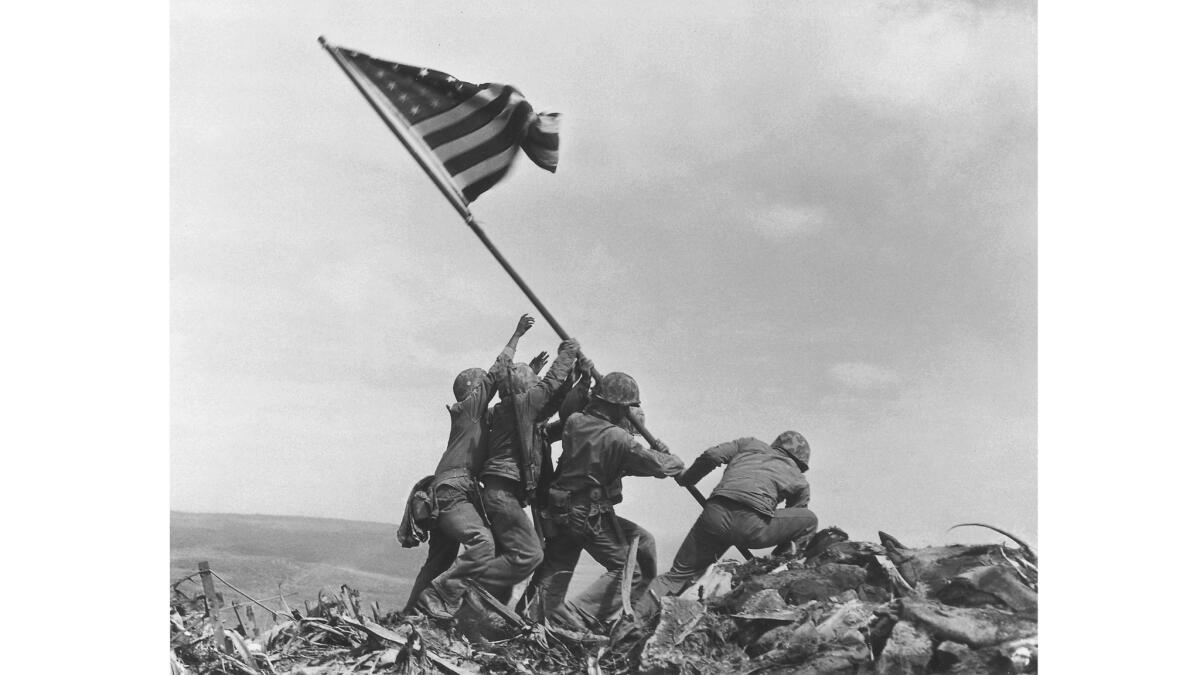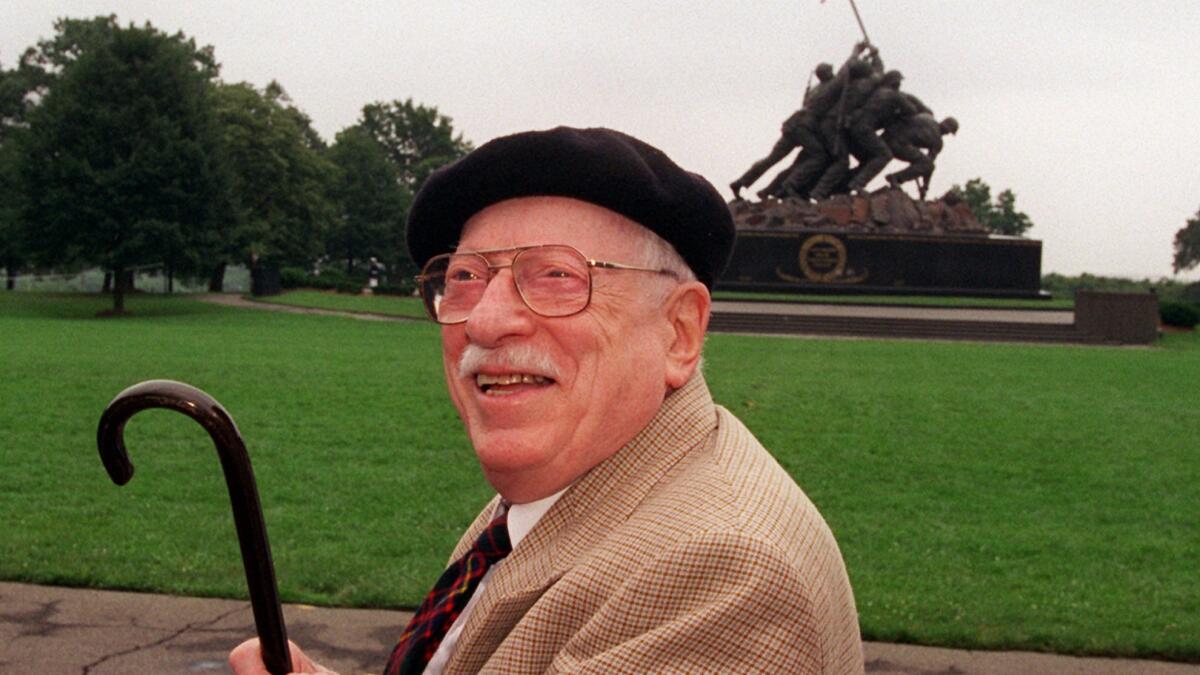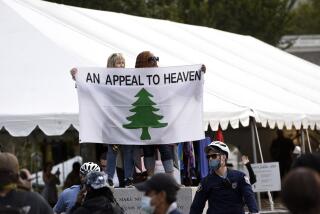Marine in iconic Iwo Jima flag photo was misidentified

- Share via
One of the men depicted in the famous photograph of Marines raising the American flag at Iwo Jima was misidentified more than 70 years ago, the U.S. Marine Corps said Thursday.
When Associated Press photographer Joe Rosenthal captured the image in 1945, the Marines identified one of the six men hoisting the flag as John Bradley, a Navy hospital corpsman. But the Marine Corps has determined that Bradley was not in the photo, and that another man, Marine Pfc. Harold Schultz, should have been credited with being there.
Schultz moved to Los Angeles after the war and worked for the postal service. He died in 1995, and never spoke publicly about appearing in the photograph.
Bradley took part in a flag raising on Mt. Suribachi earlier on the same day that the Pulitzer-winning photograph was taken. His son, James Bradley, wrote a best-selling book about the flag-raising, “Flags of our Fathers,” which was later turned into a film by Clint Eastwood.
Bradley wrote that his father didn’t talk much about the photograph but once told an interviewer, “If I knew what was going to come of that photo, I am sure I would not have jumped in and given them a hand putting that flag up.” Asked why, he said, “I could do without the pressure and the contact by the media. I’m just a private man and I’d like to leave it that way.”
The picture of the flag-raising is one of the most famous war photographs of all time. It has been reprinted in thousands of publications and is also the subject of the Marine Corps War Memorial located at Arlington Cemetery in Virginia.
The Marines invaded Iwo Jima – a small, volcanic island roughly midway between Guam and the Japanese home islands – on Feb. 19, 1945, hoping to stop Japanese fighter planes from taking off from its airfield. Japanese defenders were dug into bunkers; resistance was fierce. Ultimately, nearly 7,000 Americans were killed in what is considered the costliest battle in Marine Corps history.
On the fourth day of the invasion, Marines managed to take Mt. Suribachi, the highest point on the island, and raised a small flag. Later in the day, a larger flag was sent to the summit. The AP’s Rosenthal arrived just as it was being raised and hurriedly snapped a picture.
The photo was instantly famous – and instantly shrouded in controversy. Rosenthal was falsely accused of staging the shot, and there was confusion because of the earlier flag-raising. There also was confusion about the identity of the men raising the flag, which was largely pieced together by one of the participants, Pfc. Rene Gagnon.

Omaha-based historian Eric Krelle, working with an Irish researcher, was first to discover that the man thought to be Bradley was in fact Franklin Sousley, who was previously believed to be the man standing directly behind Bradley. But if that was Sousley, who was the man previously identified as him?
The key to solving the puzzle turned out to be a strap hanging from Schultz’s helmet, and the fact that the sling on his rifle was attached in the improper place, Krelle said. These elements are not visible in the photo, but can be seen in the video that was taken at the same time. These distinguishing factors helped Krelle match Schultz to other pictures that were taken on Mt. Suribachi that day.
Retired Marine Lt. Col. Matthew Morgan and Marine Sgt. Maj. James Dever helped bring Krelle’s findings to the attention of the Marine Corps.
“I talked to the Marine Corps very early on and they were skeptical. I knew if we were going to present anything to them, it would need to be very thorough and scientific,” said Morgan.
Morgan decided to help produce a documentary with the Smithsonian Channel to reveal the Marines’ true identities. The reports generated by the Smithsonian research team eventually prompted the formation of a Marine Corps investigative review panel by the Marine Corps’ commandant, Gen. Robert Neller.
“Our history is important to us, and we have a responsibility to ensure it’s right,” Neller said in a statement.
The panel, made up of active and retired Marines as well as military historians, confirmed that while Bradley was involved in the earlier flag raising, he was not present in the famous image.
Krelle called the discovery “overwhelming.”
“I think what I love about this is that future generations of Marines will know the truth of their history,” he said in an interview. “What they see as a symbol of their identity will depict what really happened, who was there and who actually accomplished that task.”
The New York Times reported that in May, after the investigation was announced, Bradley’s son James admitted he no longer believed his father was the man in the photo. He said he had thought so for several years, but had refrained from publicly disclosing his opinion.
In one book on the episode, “Shadow of Suribachi: Raising the Flags on Iwo Jima,” Parker Bishop Albee Jr. and Keller Cushing Freeman write: “Bradley, for his part, stressed that credit for the flag raising should be shared. He admonished reporters: ‘Tell the fellows that it took everyone on that island and the men in the ships offshore to get the flag up on Suribachi.’”
Neller, the Marine Corps commandant, said: “Although the Rosenthal image is iconic and significant, to Marines it’s not about the individuals and never has been. Simply stated, our fighting spirit is captured in that frame, and it remains a symbol of the tremendous accomplishments of our Corps – what they did together and what they represent remains most important. That doesn’t change.”
The Associated Press contributed to this report.
ALSO
FBI investigators say they have found no evidence that Orlando shooter had gay lovers
The voting ends and the counting begins as Britain decides whether to leave the European Union
Obama to voters: After the Supreme Court ruling, immigration reform is up to you now
More to Read
Sign up for Essential California
The most important California stories and recommendations in your inbox every morning.
You may occasionally receive promotional content from the Los Angeles Times.













